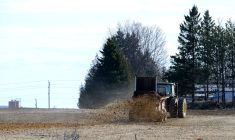An on-farm project near Sperling showcases technology that — if it lives up to its hype — could change the economics of how farmers nourish their crops.
Producers are now at the mercy of a whip-saw global nitrogen market. A production problem in Dutch natural gas fields, a conflict in Ukraine or an unexpected event like a global pandemic can upset this market, and prices can skyrocket. In the fall, a farmer might pay $400 per tonne for nitrogen, but that can climb to $1,400 by the following spring.
How about some home-grown Canadian technology that would produce anhydrous ammonia right on the farm for a stable $600 to $700 a tonne? That’s the pitch of FuelPositive, an Ontario-based firm that’s building its first on-farm ammonia plant in Manitoba. (See Don Norman’s story on page six.)
Read Also

Still hard to predict precise fertilizer payback
Despite decades of advances, international research finds no clear answer for where and when adding nutrient will fail to boost growth.
The company says its system will use water and electricity to create hydrogen and will extract nitrogen from the air. It will then pass through a proprietary “ammonia synthesis module” and the hydrogen and ammonia will be combined to create anhydrous ammonia that can be stored in on-farm tanks.
It sounds like something from a science fiction novel. And the somewhat black box nature of the synthesis model might give one pause. The world is full of snake oil pitches, after all.
However, there’s no doubt nitrogen can be created on the farm. After all, it’s all around us, making up close to 80 per cent of Earth’s atmosphere. Roughly speaking, there’s about 4,000,000,000,000,000 tonnes of it floating around. What’s less certain is how reliable the technology will be, and whether the economics will work.
To the company’s credit, it doesn’t expect people to simply take it at its word. It is on the cusp of commissioning a plant to begin production on a real-life farm. Presumably, the facts will become apparent in due course.
Farmers can judge the technology for themselves. If it is as touted, it could be a game-changer.
In a similar vein, I was recently involved in a conversation with my colleague Scott Garvey, Glacier FarmMedia’s senior editor of machinery and equipment. He talked about a recent visit to the U.S. Midwest to see a leading farm equipment manufacturer’s autonomous offerings.
As Garvey explained it, the old machinery conversation was about horsepower. The new machinery conversation is about efficiency. For example, he noted that the firm had found it could improve fuel efficiency of one field operation by eight per cent by simply dropping a gear and running the engine at less than peak RPM. It did so while still covering more ground because the unmanned machines ran longer and with fewer interruptions.
Freed of the need to have a human operator in the seat of every machine, the engineers of this new type of equipment were no longer required to make every pass count in quite the same way.
Both topics caused me to ponder how farms will be shaped in the future, influenced by these changes and others still in the blue-sky stage.
The farm sector has lived through a decades-long wave of consolidation driven by economies of scale, and just as crucially, the shortage of skilled farm labour.
When there’s just one tractor or combine operator available, the bigger the machine, the better. And when the price of a nitrogen plant was measured in the hundreds of millions, or even billions, of dollars, you’d better believe there would only be a handful sprinkled over each continent.
Will this new, less centralized model encourage continued consolidation and growth on farms? Or will it mean a rethink to find the optimal ‘shape’ of the farm of the future?
Probably the latter, but it will be a decades-long trial-and-error process, much like the post-war Green Revolution highly mechanized farm model took its own time to effect its changes. In the end, the farms two or three generations from now will be as different as the farms of today are from those 70 or 80 years ago.
Farmers will embrace that change, as history shows, but there’s a role for public policy to help them navigate the shift and develop the right tools. After all, a Manitoban can now qualify for up to $9,000 in grants and rebates to buy an electric vehicle.
Finding more efficient ways to feed the world are at least as important.
















